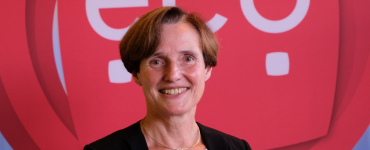eco Chair of the Board Oliver Süme foresees an evolutionary surge of the Internet: “The third generation of the Internet must also fulfil technological and regulatory requirements.”
- Climate change and Covid-19 pandemic are propelling digital transformation
- Decentralisation of the Internet and the merging of real and virtual living environments will be megatrends in 2022
- Secure, digital identities are drivers of digital transformation
- eco Association identifies further IT trends for IT security, mobility, IoT, data centres, New Work and artificial intelligence
This year, it’s not just the Covid-19 pandemic, but also the threatening climate change that will continue to drive forward digital transformation in the economy and society. “Digitalisation is part of the solution to many challenges that we will have to handle in the coming years, with or without the pandemic – be it coping with climate change, dealing with demographic change, or the constant battle for democracy and participation around the world,” says eco Chair of the Board Oliver Süme.
Two major developments that will continue to be stepped up in 2022 are an increasing decentralisation of the Internet towards cross-company and cross-sector digital ecosystems, as well as a growing fusion between real and virtual living environments.
Technologies such as artificial intelligence and virtual and augmented reality are fuelling this evolution of the Internet, which is currently being heatedly discussed under terms such as ‘Web3’ and the ‘metaverse’.
“This year, I foresee another evolutionary surge of the Internet,” says Süme. At the same time, in viewing the third Internet generation, he warns against too much euphoria and lack of caution:
“The technological and regulatory challenges remain the same. We need high-performance digital infrastructures and secure services to enable us to gain the trust and acceptance of the users in the long term.”
Süme goes on to note how the success of future evolutionary stages of the Internet will depend – as it already does today – on how the technical architecture is set up, how the balance of power is distributed, and how the opportunities for participation are shaped.
“We now have the chance to take the Internet as we know it to the next level. However, this can only be achieved if policy makers, the industry and civil society jointly tackle the mentioned challenges.”
In the view of the eco Association, the following digital technology trends will have a significant impact this year:
Secure digital identities as the drivers of digital transformation
Secure digital identities are increasingly becoming a key technology for progressive digitalisation. All the more so since, due to the Covid-19 pandemic, far more administrative procedures and business processes are being carried out online. But not only people, but also machines or companies can use a secure digital identity to have themselves verified.
In general, the solutions available today are rarely used, and users ordinarily have to register again for each new service. However, new European regulations such as eIDAS, or the eID in Germany, should make electronic identification much easier, more secure and more attractive in the future. To this end, work is being done on an ecosystem of digital identities that links the existing elements and services – from the ID card to the various private providers of digital identities – and enables and simplifies users’ straightforward, self-determined use of their digital identities.
Data centres as enablers for sustainable digitalisation
Data centres form the foundation of digital transformation and play a central role in achieving the climate goals in Germany and Europe, with their importance expected to grow significantly in 2022. The fact is: European data centres are already among the most energy-efficient in the world, with CO2 emissions from data centres declining throughout Europe since 2015. Today, data centres are already 12 times more energy-efficient than in 2010. An accelerated energy transition and the associated roll-out and availability of renewable energies will contribute to an even greater reduction in CO2 emissions from digital infrastructures in Germany.
Data centres also supply a valuable source of heat. If the necessary political, societal and economic framework conditions for waste heat utilisation are created, data centres in Germany can contribute more than 10 terawatt hours per year to the country’s heating requirements. However, the ecosystem of digital infrastructures must be thought through holistically in order to bring about sustainable digital transformation. For example, when it comes to data transport, only the nationwide deployment of fibre optics can generate more than 80% of the energy required compared to the traditional copper cables. What’s more, compared to 3G technology, the roll-out to 5G technologies also saves up to 98% of the energy needed for mobile Internet use. If we also manage to train the specialists of the future in green coding approaches, further potential savings in the use of digital solutions will be within reach.
Gaia-X advancing artificial intelligence applications
In 2022, artificial intelligence (AI) applications should benefit strongly from digital ecosystems and cross-company data spaces like Gaia-X. On the strength of these, the likes of AI-based service ecosystems covering technical service for Industry 4.0 are gaining traction. In Germany, new use cases and business models are emerging within the Service-Meister project, based on the self-determined exchange of training data for machine-learning applications. IT service providers, car repair shops and other projects from the automotive sector and industry stand to benefit from this. The open-source software modules of the Gaia-X project, which will become available in mid-2022, will enable innovations based on shared data spaces.
Protecting IT supply chains from ransomware attacks
With more and more decentralised IT resources in companies, the requirements for IT security will also undergo change in 2022. Not only IT in the company, but entire supply chains require more and more protection against cyber attacks. The mounting complexity is also triggering a growth spurt in the number of possible points of attack for criminals. SMEs in particular will remain particularly exposed to this risk in 2022. The trend towards ransomware will most likely continue in 2022, especially among SMEs. Companies’ IT security concepts must include suppliers and service providers in the IT supply chain more than they have ever done before. Companies should also ensure continuous awareness-raising among employees to protect against phishing attacks.
Growing trust in the Internet of Things (IoT)
Consistent establishment of security standards for IoT devices is an important trend in the Internet of Things. A security label – which in Germany this year can be applied for at the German Federal Office for Information Security (BSI) – constitutes data protection and security and can thus strengthen people’s trust in a secure IoT and also initiate new innovation potentials in connection with Web3. As a prerequisite for the implementation of IoT projects, the roll-out of digital infrastructures – especially the nationwide roll-out of mobile high-speed Internet – remains an important topic this year.
Traffic watershed setting multimodal mobility solutions in motion
The connectivity of new mobility services and public transport that has already begun will further intensify in 2022. Consumers will benefit from this in 2022 and will be able to easily book the new multimodal mobility options such as rental bikes and transport services on their mobile phones. Rising fuel prices and the trend towards car-free city centres are driving forward this development. In rural regions in particular, area-wide mobile Internet coverage is an absolute must. New business concepts are emerging around the generated mobility data to further improve the mobility services for people in the city and in the countryside – as part of a traffic watershed involving a move away from private cars. Buzzwords such as “Smart City” and “Smart Region” are increasingly becoming part of real-life politics and life experiences. The economic and sustainable significance of this trend can not be overestimated (link to Smart City Study).
New Work concepts tackling the shortage of skilled workers
More and more, the shortage of skilled workers is delivering growing challenges to HR managers. This makes it necessary to think and recruit “outside of the box”. Aside from more diversity, what this also signifies is the option of recruiting more skilled workers from abroad. In this regard, established tools for digital cooperation across national borders are an important precondition. Hybrid and flexible working models are becoming increasingly prevalent and are establishing themselves as the new standard. In the application process, the responsible use of algorithms, employer branding, new matching platforms and personality tests are also expanding the pool of applicants.




